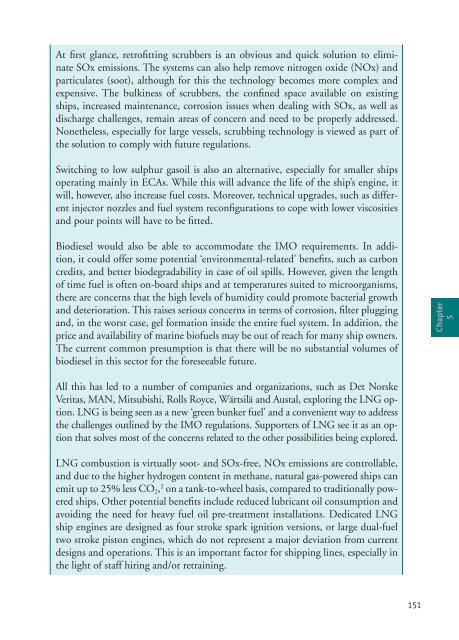World Oil Outlook - Opec
World Oil Outlook - Opec
World Oil Outlook - Opec
- TAGS
- world
- outlook
- opec
- www.opec.org
Create successful ePaper yourself
Turn your PDF publications into a flip-book with our unique Google optimized e-Paper software.
At first glance, retrofitting scrubbers is an obvious and quick solution to eliminate<br />
SOx emissions. The systems can also help remove nitrogen oxide (NOx) and<br />
particulates (soot), although for this the technology becomes more complex and<br />
expensive. The bulkiness of scrubbers, the confined space available on existing<br />
ships, increased maintenance, corrosion issues when dealing with SOx, as well as<br />
discharge challenges, remain areas of concern and need to be properly addressed.<br />
Nonetheless, especially for large vessels, scrubbing technology is viewed as part of<br />
the solution to comply with future regulations.<br />
Switching to low sulphur gasoil is also an alternative, especially for smaller ships<br />
operating mainly in ECAs. While this will advance the life of the ship’s engine, it<br />
will, however, also increase fuel costs. Moreover, technical upgrades, such as different<br />
injector nozzles and fuel system reconfigurations to cope with lower viscosities<br />
and pour points will have to be fitted.<br />
Biodiesel would also be able to accommodate the IMO requirements. In addition,<br />
it could offer some potential ‘environmental-related’ benefits, such as carbon<br />
credits, and better biodegradability in case of oil spills. However, given the length<br />
of time fuel is often on-board ships and at temperatures suited to microorganisms,<br />
there are concerns that the high levels of humidity could promote bacterial growth<br />
and deterioration. This raises serious concerns in terms of corrosion, filter plugging<br />
and, in the worst case, gel formation inside the entire fuel system. In addition, the<br />
price and availability of marine biofuels may be out of reach for many ship owners.<br />
The current common presumption is that there will be no substantial volumes of<br />
biodiesel in this sector for the foreseeable future.<br />
All this has led to a number of companies and organizations, such as Det Norske<br />
Veritas, MAN, Mitsubishi, Rolls Royce, Wärtsilä and Austal, exploring the LNG option.<br />
LNG is being seen as a new ‘green bunker fuel’ and a convenient way to address<br />
the challenges outlined by the IMO regulations. Supporters of LNG see it as an option<br />
that solves most of the concerns related to the other possibilities being explored.<br />
LNG combustion is virtually soot- and SOx-free, NOx emissions are controllable,<br />
and due to the higher hydrogen content in methane, natural gas-powered ships can<br />
emit up to 25% less CO2, 2 on a tank-to-wheel basis, compared to traditionally powered<br />
ships. Other potential benefits include reduced lubricant oil consumption and<br />
avoiding the need for heavy fuel oil pre-treatment installations. Dedicated LNG<br />
ship engines are designed as four stroke spark ignition versions, or large dual-fuel<br />
two stroke piston engines, which do not represent a major deviation from current<br />
designs and operations. This is an important factor for shipping lines, especially in<br />
the light of staff hiring and/or retraining.<br />
151<br />
Chapter<br />
5
















